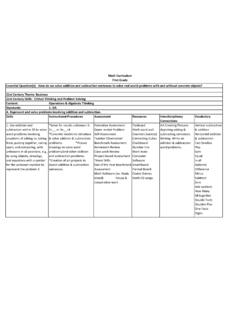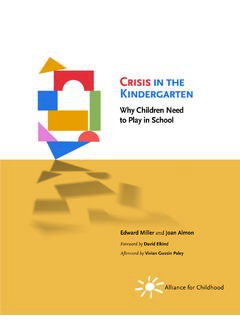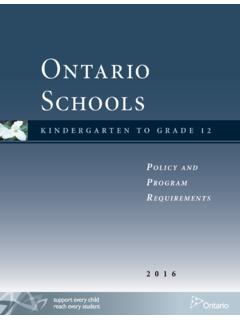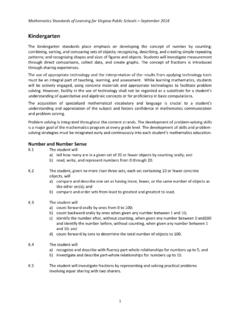Transcription of Kindergarten Essential Question(s): How does counting help ...
1 Math Curriculum KindergartenEssential Question(s): How does counting help us in our everyday lives?21st Century Theme: Business21st Century Skills: Communication and Collaboration/ Integrating TechnologyContent: counting and ProceduresAssessmentResources Interdisciplinary ConnectionsVocabulary1. Count to 100 by ones and by tensModel counting using decod words with and without pictures. counting with manipulatives Clapping out numbers CalendarFormative Assessment Open- ended Problem Self Assessment Teacher Observation Benchmark Assessment Homework Review Classwork Review Project-Based Assessment Timed Drills End of the Year Benchmark Assessment Math Software (ex.)
2 Study Island) Group & cooperative work Number chats Calendar Problem of the day counting Manipulatives Games Calculator SmartBoards/Tables Block Center Ten Frame Number LineMusic: Dr. Jean Songs Literature: Reese's Pieces Count by Tens by: Jerry PallottaNumbers More/Less Same/ Different Left/ Right 2. Count forward beginning from a given number within the known sequence (instead of having to begin at 1).Ask children to finish sequence when starting with a random number CalendarSame as aboveNumber line Fingers Oral discussion CalendarFile folder Games Math Stories Center ActivitiesSequence First, Second, Before/ AfterA.
3 Know number names and the count Curriculum Kindergarten3. Write numbers from 0 to 20. Represent a number of objects with a written numeral 0-20 (with 0 representing a count of no objects).Write numbers for a purpose (Such as taking the lunch count.) Students will write/form written numerals 0-20 Students illustrate objects based on that number Count to tell number of objectsSame as aboveManipulatives SmartBoards Small chalkboards or white boardsSongs & number writing poems- Art Center activity- make a number book and illustrate Science- counting nature objects, pinecones, seeds, etc.
4 Journal writingNumber VocabularyMath Curriculum KindergartenEssential Question(s): Content: counting and Cardinality21st Century Theme: ProceduresAssessmentResources Interdisciplinary ConnectionsVocabularyB. Count to tell the number of Curriculum Kindergarten4. Understand the relationship between numbers and quantities; connect counting to cardinality. When counting objects, say the number names in the standard order, pairing each object with one and only one number name and each number name with one and only one that the last number name said tells the number of objects counted. The number of objects is the same regardless of their arrangement or the order in which they were that each successive number name refers to a quantity that is one counting to cardinality Pairing objects with number name Understanding each successive number name refers to a quantity that is one largerFormative Assessment Open- ended Problem Self Assessment Teacher Observation Benchmark Assessment Homework Review Classwork Review Project-Based Assessment Timed Drills End of the Year Benchmark Assessment Math Software (ex.)
5 Study Island) Group & cooperative work SmartBoard/ Table counting Objects Manipulatives AbacusScience Center: Collecting and counting leaves or other objects from nature Physical Education: counting jumping jacks, sit ups, lessMath Curriculum Kindergarten5. Count to answer how many? questions about as many as 20 things arranged in a line, a rectangular array, or a circle, or as many as 10 things in a scattered configuration; given a number from 1 20, count out that many opportunities to look at a group of items to determine the quantity Classify/ sorting objects and then counting Same as aboveDominoes Blocks Manipulatives Objects to countWorld Languages: Saying numbers in different languages Science: Classifying and sorting objects from nature ex.
6 Leaves, sea shell, manyMath Curriculum KindergartenEssential Question(s): 21st Century Theme:Content: counting and ProceduresAssessmentResources Interdisciplinary ConnectionsVocabulary6. Identify whether the number of objects in one group is greater than, less than, or equal to the number of objects in another group, , by using matching and counting objects to compare numbers Sorting and comparing objects to determine the relationship between the twoFormative Assessment Open- ended Problem Self Assessment Teacher Observation Benchmark Assessment Homework Review Classwork Review Project-Based Assessment Timed Drills End of the Year Benchmark Assessment Math Software (ex.)
7 Study Island) Group & cooperative work Dominoes Blocks Manipulatives Objects to countScience: comparing quantities of objects from natureMore/less Greater than Less than Most Same Least Fewer Equal to7. Compare two numbers between 1 and 10 presented as written use number lines to determine numerals and quantitySame as aboveNumber line Number Cards SmartBoardNumerals 1-10 Compare NumbersMath Curriculum KindergartenMath Curriculum KindergartenEssential Question(s): How can you use objects to solve joining and separating problems?
8 21st Century Theme: Global Awareness21st Century Skills: Critical Thinking and Problem SolvingContent:Operations and Algebraic ProceduresAssessmentResources Interdisciplinary ConnectionsVocabulary1. Represent addition and subtraction with objects, fingers, mental images, drawings1, sounds ( , claps), acting out situations, verbal explanations, expressions, or to Whole: Take two groups and make them into one whether adding or subtracting by exploring the combinations of numbersFormative Assessment Open- ended Problem Teacher Observation Homework Review Classwork Review Project-Based Assessment End of the Year Benchmark Assessment Math Software (ex.)
9 Study Island) Group & cooperative work Counters Coins Students Connecting Cubes Beads on a pipe cleaner Poems Songs Literature: Domino Addition by: Lynette Long Elevator Magic by: Stuart J. Murphy Language Arts: Write a sentence about the number sentence. Dramatic Play: Act out addition and subtraction problemsTotal In all How Many Together Add Subtract Difference What's left Plus Minus Is equal to One more/less Take away What remains Have enough Still remaining2.
10 Solve addition and subtraction word problems, and add and subtract within 10, , by using objects or drawings to represent the addition and subtraction stories using real objects, next play objects, then counters, and lastly as aboveCounters Coins Students Connecting Cubes Beads on a pipe cleaner Dice Dominos Spinners Flash Cards Language Arts: Students write their own math story. Art: Students illustrate their math storySame as aboveUnderstand addition as putting together and adding to, and understand subtraction as taking apart and taking Curriculum Kindergarten3. Decompose numbers less than or equal to 10 into pairs in more than one way, , by using objects or drawings, and record each decomposition by a drawing or equation ( , 5 = 2 + 3 and 5 = 4 + 1).





